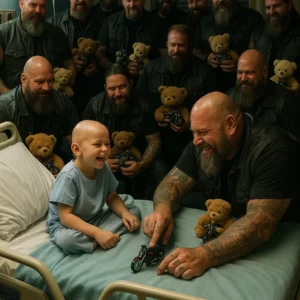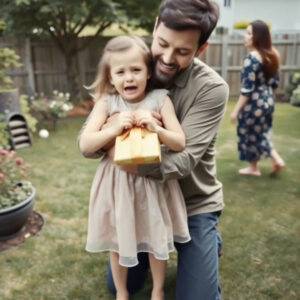When Dr. Elwar told me my blood sugar was “borderline high,” I smiled and nodded, pretending to take it in stride. But the truth? It scared me more than I expected.
I’m not the kind of person who cries easily, but that night I sat in my car in the parking lot, hands gripping the steering wheel, feeling something between shame and helplessness.
I’m only 43. I don’t drink, I don’t smoke. Okay, maybe I love bread a bit too much, and I’ve never met a dessert I didn’t like—but I always thought I was doing “just enough” to stay healthy.
But now… my “just enough” wasn’t enough anymore.
The next morning, I texted my younger cousin Kael. He’s a certified nutritionist and a little too enthusiastic about chia seeds. But I figured if anyone could help me figure out a game plan that didn’t involve swallowing pills forever, it’d be him.
“Let’s walk and talk,” he texted back. “Coffee and sneakers. I’ll pick you up at 8.”
That first walk nearly killed me. Not physically—I mean, we were just strolling the neighborhood. But Kael didn’t sugarcoat anything.
“A borderline reading is a warning, Bren,” he said, sipping his black coffee like it was magic. “You can change this. But not if you keep eating the way you do and skipping movement.”
I wanted to argue. Say something like, “But I’m not THAT bad.”
Instead, I just nodded. Because he was right.
We started walking every morning. Just twenty minutes at first. We’d talk about everything—life, memories from when we were kids, random gossip about the family. It made the time fly.
And slowly, I started shifting other things, too.
I stopped buying soda. I swapped my sugary cereal for eggs and avocado toast. I Googled “low-glycemic fruits” and found out I actually liked berries more than bananas.
It wasn’t perfect. I still had the occasional pastry at the office. And once, during a really rough week, I finished a pint of cookie dough ice cream in one sitting.
But something was different now. I wasn’t doing this just to avoid medication. I was doing it to feel like myself again.
About a month in, my boss, Arvin, stopped me in the breakroom.
“You look… lighter,” he said, then quickly added, “I mean that in a good way.”
I laughed. “I’ve been making some changes.”
He smiled and gave a thumbs-up. “Keep going. You’re glowing or something.”
I didn’t know I needed that encouragement until I got it. Sometimes, it’s the little things that remind you you’re on the right path.
But then—life threw a wrench in everything.
My mom called one night, frantic. My aunt Lira had collapsed at home. She’d been hiding her Type 2 diabetes diagnosis for months and wasn’t taking her meds properly.
She survived, thank God. But seeing her in that hospital bed, pale and weak, shook me. She used to be the most vibrant woman I knew—always dancing at family parties, always making everyone laugh.
Now she looked like a shadow of herself.
“I thought I could manage it on my own,” she whispered when I visited. “I didn’t want anyone worrying about me.”
That hit home. Because wasn’t I doing the same? Trying to “handle” things quietly, hoping no one would notice?
The truth is—health isn’t just physical. It’s emotional. And it’s not a solo project.
That night, I sat at my kitchen table with a journal and wrote down every reason I wanted to get better:
I want to be around for my niece’s graduation.
I want to feel strong and energized in the mornings.
I want to travel without worrying about medications or doctor’s notes.
I want to dance at weddings again without feeling self-conscious.
I want to be the one taking care of others, not the one being taken care of.
The next morning, I woke up at 6:30 AM and made a veggie-packed omelet. No toast, no juice—just water and protein. It wasn’t glamorous, but it felt good.
The little changes started stacking up.
I discovered zucchini noodles. I learned how to roast chickpeas until they were crunchy. I swapped late-night TV snacks for tea and a handful of almonds.
People started noticing. My skin cleared up. I had more energy during the day. I was even sleeping better.
Kael kept pushing me—gently, but firmly. “It’s about consistency, not perfection,” he reminded me.
Then came the six-month check-up.
I sat in the cold exam room, nervously flipping through a two-month-old magazine, wondering if all this effort had actually done anything.
Dr. Elwar came in, looked at her screen, then looked at me with a slow, proud smile.
“Your numbers are down. You’re back in the normal range.”
I exhaled so hard, I think I startled her.
“But keep going,” she added. “You did the hard part—now it’s about maintenance.”
That night, I went out to dinner with some friends I hadn’t seen in months. They noticed the difference right away.
“You’re glowing,” Taz said, reaching across the table to grab my hand. “Seriously, what changed?”
“I just started taking care of myself,” I said, and meant it.
But here’s the twist I didn’t see coming.
One week later, I got a message from Kael.
“Need to talk. Something happened.”
His voice cracked on the phone. His father—my uncle Edric—had just been diagnosed with advanced kidney failure. Years of high blood pressure and untreated diabetes had caught up with him.
I sat there, heart pounding, as Kael explained everything. How his dad had ignored symptoms. How the family assumed he was “just tired.” How no one asked the hard questions.
“I feel like I failed him,” Kael said. “I should’ve pushed more.”
But I didn’t think that was fair. We all have to want to be helped. We all have to decide we’re worth saving.
That night, I made a decision.
I started a small blog—nothing fancy. Just a place where I wrote down what I was learning. Simple meal ideas. Walking routines. The emotional stuff no one talks about.
I called it “Still In My Control.”
And to my surprise, it took off.
People started messaging me—friends, coworkers, even strangers.
“Thank you for sharing this. I’ve been scared to go to the doctor.”
“My mom has the same numbers. I’m going to help her walk every day.”
“I thought I was the only one hiding snacks under my bed.”
I realized something powerful: being vulnerable wasn’t weakness. It was connection.
It gave others permission to care about themselves, too.
A few months later, I hosted a small community walk-and-talk event in the park. I thought maybe ten people would show up.
Thirty-two came.
Some brought their dogs. Some came with their parents. One woman, Rina, showed up with a printed folder of all my blog posts and said, “You saved my life.”
I didn’t cry then. But later, alone in my car again, I let it out.
Because sometimes, you think you’re just trying to fix your own life—but you end up helping others find their way too.
I’m still not perfect. I still want cinnamon rolls when I’m sad. I still have to fight the urge to skip workouts when it rains.
But now I know my “why.”
It’s bigger than just blood sugar. It’s about showing up for myself—over and over again.
If you’re in that same spot right now—borderline numbers, borderline motivation—I just want you to know something:
You’re not too far gone.
Every step you take toward health counts. Every time you say “no” to the easy thing and “yes” to the right thing, you’re building something.
Momentum. Resilience. Life.
Your story can shift. Just like mine did.
And who knows? You might even end up helping someone else rewrite theirs, too.
Life Lesson:
Sometimes the warning signs we fear most are actually invitations—to slow down, reevaluate, and return to ourselves. Taking control of your health isn’t just about numbers—it’s about reclaiming your power, one small step at a time.
If this story resonated with you, please like and share it—someone out there needs the reminder that it’s not too late to turn things around. ❤️





